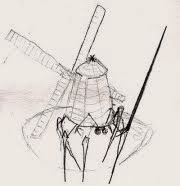The most basic design has to be able to avoid running into walls, and it has to be able to avoid falling over edges. Cliff detection and collision detection ; a neuralogical demand somewhere around a amoeba's.
I would also like it to keep a record on punched tape of its travels, and perhaps a odometer count.
Travel records open a new, and interesting can of worms.
Consider 'Direction of Travel'. In the simpliest form, this is left-right-forward-back. But how many 'lefts' does it take to turn a complete circle? The value is not uniform - tire slippage and real world factors act to vary the angles.
But to switch from relative reference to absolute would require a real-world frame of reference.
Bacteria and pigeons use magnetic fields. A compass would work, but would deviate badly in the electromagnetic fields that permeate our indoor enviroment.
Likewise, there are too many light sources to use a 'solar' based frame of reference. Look how badly moths do when they encounter streetlights.
A tiny gyroscope would be ideal, but I am not certain if one could be built that fits within size restraints.
Or perhaps I should say, ' size and patience' restraints - the smaller the scale, the more fiddly the manufacture.
Each cog neuron can be built with 4 possible inputs:
Fire ... which immediately triggers the neuron, unless it is in relaxation time;
Enable_Fire ... which allows the neuron to fire if a signal arrives;
Inhibit_Fire ... which prevents the neuron from firing until the signal is removed;
Inhibit_Reset ... which prevents the neuron from coming out of relaxation -
when the signal is removed, the neuron will still complete its normal relaxation time before resetting.
While Enable_Fire and Inhibit_Fire would seem to be binary choices, the neuron could have Inhibit_Fire and Enable_Fire set or unset by different neurons. A AND gate could be set up by using the Fire and the Enable_Fire inputs together. A NAND could use Fire and Inhibit_Fire together.
Its really not a question of gates though. The idea has been from the beginning to mimic neurons rather than gates, although this means I have to master networks rather then Boolean Logic.
Fire ... which immediately triggers the neuron, unless it is in relaxation time;
Enable_Fire ... which allows the neuron to fire if a signal arrives;
Inhibit_Fire ... which prevents the neuron from firing until the signal is removed;
Inhibit_Reset ... which prevents the neuron from coming out of relaxation -
when the signal is removed, the neuron will still complete its normal relaxation time before resetting.
While Enable_Fire and Inhibit_Fire would seem to be binary choices, the neuron could have Inhibit_Fire and Enable_Fire set or unset by different neurons. A AND gate could be set up by using the Fire and the Enable_Fire inputs together. A NAND could use Fire and Inhibit_Fire together.
Its really not a question of gates though. The idea has been from the beginning to mimic neurons rather than gates, although this means I have to master networks rather then Boolean Logic.
Subscribe to:
Comments (Atom)

